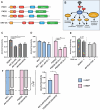This is a preprint.
Natural variation in protein kinase D modifies alcohol sensitivity in Caenorhabditis elegans
- PMID: 38895441
- PMCID: PMC11185769
- DOI: 10.1101/2024.06.09.598102
Natural variation in protein kinase D modifies alcohol sensitivity in Caenorhabditis elegans
Abstract
Differences in naïve alcohol sensitivity between individuals are a strong predictor of later life alcohol use disorders (AUD). However, the genetic bases for alcohol sensitivity (beyond ethanol metabolism) and pharmacological approaches to modulate alcohol sensitivity remain poorly understood. We used a high-throughput behavioral screen to measure acute behavioral sensitivity to alcohol, a model of intoxication, in a genetically diverse set of over 150 wild strains of the nematode Caenorhabditis elegans. We performed a genome-wide association study to identify loci that underlie natural variation in alcohol sensitivity. We identified five quantitative trait loci (QTL) and further show that variants in the C. elegans ortholog of protein kinase D, dkf-2, likely underlie the chromosome V QTL. We found that resistance to intoxication was conferred by dkf-2 loss-of-function mutations as well as partly by a PKD inhibitor in a dkf-2-dependent manner. Protein kinase D might represent a conserved, druggable target to modify alcohol sensitivity with application towards AUD.
Keywords: GWAS; alcohol sensitivity; protein kinase D.
Conflict of interest statement
Competing interests: The authors declare no competing interest.
Figures



Similar articles
-
Properties, regulation, and in vivo functions of a novel protein kinase D: Caenorhabditis elegans DKF-2 links diacylglycerol second messenger to the regulation of stress responses and life span.J Biol Chem. 2007 Oct 26;282(43):31273-88. doi: 10.1074/jbc.M701532200. Epub 2007 Aug 29. J Biol Chem. 2007. PMID: 17728253
-
Conserved domains subserve novel mechanisms and functions in DKF-1, a Caenorhabditis elegans protein kinase D.J Biol Chem. 2006 Jun 30;281(26):17815-26. doi: 10.1074/jbc.M511898200. Epub 2006 Apr 13. J Biol Chem. 2006. PMID: 16613842
-
Characterization of a novel protein kinase D: Caenorhabditis elegans DKF-1 is activated by translocation-phosphorylation and regulates movement and growth in vivo.J Biol Chem. 2006 Jun 30;281(26):17801-14. doi: 10.1074/jbc.M511899200. Epub 2006 Apr 13. J Biol Chem. 2006. PMID: 16613841
-
Drosophila and Caenorhabditis elegans as Discovery Platforms for Genes Involved in Human Alcohol Use Disorder.Alcohol Clin Exp Res. 2015 Aug;39(8):1292-311. doi: 10.1111/acer.12785. Epub 2015 Jul 14. Alcohol Clin Exp Res. 2015. PMID: 26173477 Free PMC article. Review.
-
Beyond genome-wide significance: integrative approaches to the interpretation and extension of GWAS findings for alcohol use disorder.Addict Biol. 2019 Mar;24(2):275-289. doi: 10.1111/adb.12591. Epub 2018 Jan 9. Addict Biol. 2019. PMID: 29316088 Free PMC article. Review.
References
Publication types
Grants and funding
LinkOut - more resources
Full Text Sources
Research Materials
